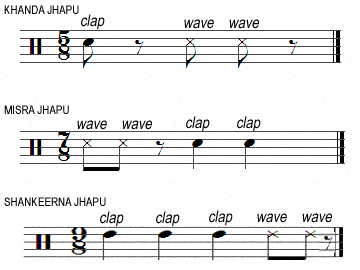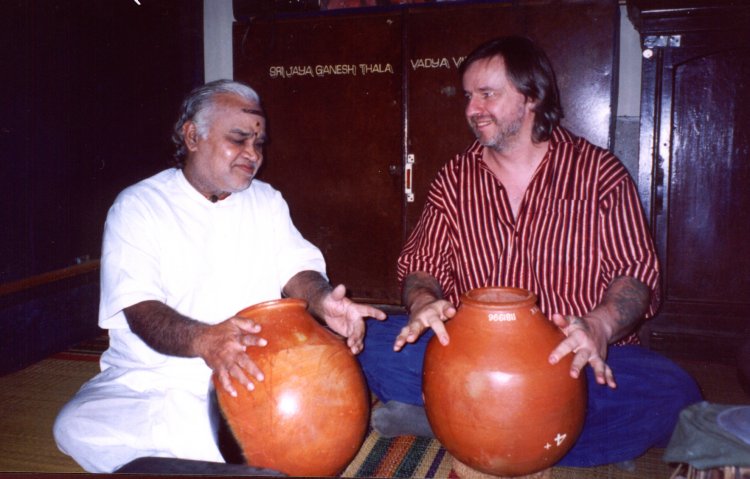|
We are going to analyse the basics of
Carnatic rhythm cycle clapping patterns and see how these patterns are
structured. We will start right at the very beginning and move on
to the seven basic Sapta' thala structures and their derivatives. (To
put it simply, 'thala' equates to western time signature or time cycle).
Anyone who is familiar with Carnatic music or fusion projects such as
Shakti will have noticed the members of the group clapping out time
cycles which the others play to. These patterns are an elaborate
structure of claps, waves and finger counts which mark out the time
cycle in a rigorous and metronomic way. The time cycles are
divided into sections, each represented with their relevant claps, waves
and gestures. We are going to start right at the beginning with a
simple quarter note clap. Begin by clapping a steady pulse, either
in the palm of your hand or with your hand on your thigh. This is
great to mark the pulse but not the meter or duration. It is
simply a one beat clap. By using our fingers we can begin to
define the meter. We will start with a simple 3/4 cycle,
clapped either in your other palm or else on your thigh. We will
have one main clap on beat one of the bar, count off beat two with the
little finger and beat three with the ring finger. The motions do
not need to be loud but do need to be clear to the observer so they can
see where in the bar they are at any one point. Keep this going
round in a loop as in the diagram below. Each single beat is
called an akshara.

Beat one
Beat two Beat three
Now lets try the same but with a count on
one extra finger to make up a bar of 4/4.

Beat one
Beat two
Beat three
Beat four
Now lets try the same but with a count on
one extra finger to make up a bar of 5/4.

Beat one Beat two Beat three Beat four Beat five
We can count to higher numbers in this
fashion by using the thumb for beat six and then going back to the
little finger which would then be beat seven, the ring finger for beat
eight and the middle finger for beat nine. It is not usual to go
beyond nine for this way of counting. This will become a little
clearer when we get a little deeper into thalum
(time cycle)
construction.

Beat six
Beat seven
Beat eight Beat nine
We now already have one important
aspect of Carnatic thalum construction. It's technical name is
called 'LAGHU' and is the corner stone of the seven basic 'SAPTA' thalas.
To summarise, a 'LAGHU' is a unit of equidistant measures marked by a
clap followed by a set number of finger counts. This number
of finger counts is dictated by the name of a particular thala
which
indicates how many counts there are in each Laghu within that thala.
This will become clear a little later on when we look at the
thala types
and their structures. It is also worth noting at this point that
although some South Indian thalas resemble their
North Indian
counterparts, they are actually very different in their basic form.
There are two simple elements to add to
give us all out thalum construction components, a unit comprised of a
single clap and a unit comprised of a clap and a wave. The
technical terms for these are 'DRUTHAM' (clap+wave) and 'ANU-DRUTHAM
(clap). All the basic Sapta thalas are derived from combinations
of DRUTHAM, ANU-DRUTHAM & LAGHU. (These units are called angams).
There are seven commonly used
combinations of these elements currently in use in South India.
Each form of structure has a name which makes up part of the final name
of the thala. (IE; This part of the name identifies the overall
construct whilst another part of the name identifies other elements of
the thala, such as the length of the finger counting sections etc).
Lets take this combination of our units:
1 X FINGERCOUNTING SECTION (1 X LAGHU) +
2 X CLAP / WAVE SECTION
(2 X DRUTHAM)
This form (LAGHU + DRUTHAM + DRUTHAM) is
called 'TRIPUTA THALUM' and is always the same. At the moment
though we do not know how long the finger counting section is. Lets for
argument sake make it four beats long. This would give us four
beats in the finger counting section plus two groups of clap / wave,
totalling eight beats in all. It would be clapped like this:

Beat one Beat two Beat three
Beat four

Beat five Beat six
Beat seven Beat eight
To tell us how long the finger counting
section is, a prefix is added to the front of the thalum name. In this
instance, our Laghu is four beats long. Four in Tamil is
Chaturusra, therefore we get the full name of 'CHATURUSRA JHATI TRIPUTA
THALA' It is very important to understand these names because they
contain all the elements that tell you the combinations of claps, waves
and finger counting sections (Laghus) as well as the length of each of
finger counting sections.
'CHATURUSRA JHATI means:
Four (Chaturusra) beats in the Laghu.
TRIPUTA THALA means:
1 X FINGERCOUNTING SECTION (1 X LAGHU) +
2 X CLAP / WAVE SECTION
(2 X DRUTHAM)
CHATURUSRA JHATI TRIPUTA TALTAL
(8)
 (Video)
(Video)
Actually this is the most common thala in
Carnatic music. Its shortened common use name is 'ADI THALA'
Now, lets stick with 'TRIPUTA' thala but
make our laghu five beats long. 'KHANDA' means five in Tamil so we
would have the name of 'KHANDA JHATI TRIPUTA THALA'
This would make our thalum length nine beats and would be counted like
this. The form is the same, (LAGHU + DRUTHAM + DRUTHAM but
will be 5 + 2 + 2)

Beat one Beat two Beat
three
Beat four Beat five

Beat six
Beat seven
Beat eight
Beat nine
KHANDA JHATI TRIPUTA TAL
(9)
 (Video)
(Video)
Regarding the finger counts for each
Laghu section.
There are usually five different length units used and they are;
THREE BEAT COUNT called THISRA
FOUR BEAT COUNT called CHATURUSRA
FIVE BEAT COUNT called KHANDA
SEVEN BEAT COUNT called MISRA
NINE BEAT COUNT called SHANKEERNA
Similarly there are seven different forms of overall
Thalum construction which piece together the general elements in the
same way as out 'TRIPUTA THALA'. These are:
DHRUVA THALA =
LAGHU + DRUTHAM +
ANU-DRUTHAM + LAGHU
MATYA THALA =
LAGHU + DRUTHAM +
LAGHU
RUPAKA THALA =
DRUTHAM + LAGHU
JHAMPA THALA =
LAGHU + ANU-DRUTHAM +
DRUTHAM
TRIPUTA THALA =
LAGHU + DRUTHAM +
DRUTHAM
ATA THALA =
LAGHU + LAGHU + DRUTHAM +
DRUTHAM
EKA THALA = LAGHU
With the combination of these seven thala types with the
five prefixes to determing the length of the finger counting 'laghu'
sections we arrive at a sum total of thirty five main sapta thalas in
use today in South India. (7 x 5 = 35)
Lets take an example. 'THISRA JHATI RUPAKA THALUM'.
Thisra is our three beat count. Rupaka involves the juxtoposition
of one 'Drutham...clap / wave) and one finger counting section three
beats long. It therefore becomes 2 + 3, a five beat thalum.
'SHANKEERNA JHATI RUPAKA THALUM' would involve the same thalum structure
but the finger counting section would be nine beats long. 2 + 9,
therefore an eleven beat thalum.
There are also some other elements which dictate the way
the finer elements of the Thalum is configured. The first is 'KALLAI'. The thalum we have clapped so far have all been 'one Kallai' which means that there is one quarter note per equidistant
count. Two Kallai will use 2 beats for every one beat of the thalum.
This effects the speed of the song and the length of the time cycle
because each single clap, wave or finger count of the thalum will be
twice the length, half notes instead of quarters.
Therefore, a one kallai three beat laghu would be
counted;
CLAP, LITTLE FINGER, RING FINGER
The two kallai three beat laghu would be counted;
CLAP, (clap), LITTLE FINGER, (little finger), RING FINGER, (ring
finger).
It would be twice the length of the one Kallai version.
It is usual for the bracketed counts to be motioned subtly to mark time
with the stress falling on the main beats.
We then find this information after the main Thalum name.
For example; 'CHATURUSRA JHATI TRIPUTA
THALA, ONE KALLAI CHOWKUM' or 'CHATURUSRA JHATI TRIPUTA
THALA, TWO KALLAI CHOWKUM' (Chowkum meaning
division or spacing). They also quite often use Tamil numbers
instead of English.
Finally, we have to know how each individual beat is
constructed. Is it four per beat (16ths), three per beat
(triplets), five per beat (Quintuplets) etc. This is called 'GATI'
in Tamil music terms. Here are the five potentialities.
TRIPLETS are called THISRA GATI (Thisra means three)
SIXTEENTHS are CHATURUSRA GATI (Chaturusra means four)
QUINTUPLETS are KHANDA GATI (Khanda means five)
SEPTUPLETS are MISRA GATI (Misra is seven)
NOTUPLETS are SHANKEERNA GATI (Shankeerna is nine)
So, this means that we can have another extension to the
Thalum name to designate the 'notes per quarter' ratio. For example;
'CHATURUSRA JHATI TRIPUTA
THALA, ONE KALLAI CHOWKUM,
THISRA GATI' or 'CHATURUSRA JHATI TRIPUTA
THALA, TWO KALLAI CHOWKUM,
KHANDA GATI'
Some people maintain that these post scripts actually make them
different Thalums but I don't really adhere to that perspective, in the
same way that 4/4 is still 4/4 if you are playing triplets, quintuplets
or whatever.
It must be mentioned that the
Thalum system commonly in use in South India, although complex is
only part of what can only be described as a VERY complex method of
clapping time. Apart from the thirty five
Thalas above, there is another set of talas called
'Marga Talas'. These talas use additional
clapping units (angams) other than laghu, drutham and anu-drutham called
Guru, Plutham, Kakapadam etc. These invole motioning with the hand
in the air, to the left, to the right, with a clenched fist etc.
They are very involved ancient Thalas rarely used today, consisting of:
GURU - 1 beat and counting 7 fingers
PLUTHAM - 1 beat, 1 krshyai & 1 sarpini
KAKAPADAM - 1 beat, 1 krshyai, 1 sarpini &
1 pathakam
1 krshyai - waving the hand towards left,
it has 4 aksharas
1 sarpini - waving the hand towards right,
it has 4 aksharas
1 pathakam - raising the hand vertically,
has 4 aksharas
There are also the CHAPU THALAS
which are in regular use today. These are:

Re-cap by givng these mp3's a listen through.
INTRODUCING
CARNATIC THALA 1 mp3
INTRODUCING
CARNATIC THALA 2 mp3
INTRODUCING
CARNATIC THALA 3 mp3
INTRODUCING
CARNATIC THALA 4 mp3
We also find the chapu tals in common use
in Carnatic classical music.
KHANDA JHAPU TAL
(5)
 (Video)
(Video)
MISRA JHAPU TAL
(7)
 (Video)
(Video)


|
